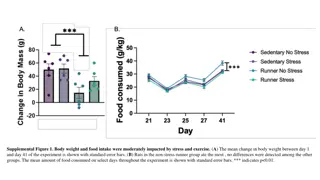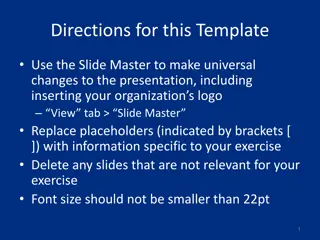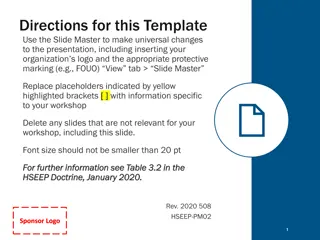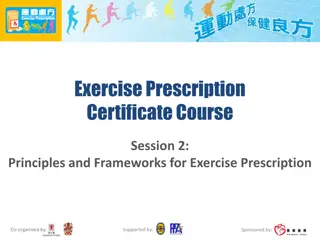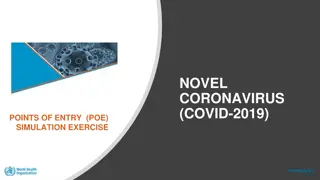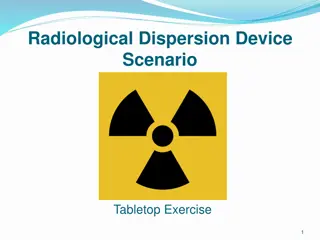Exercise 3C Exercise 3C
Graphically solve simultaneous equations, including linear and quadratic equations. Learn to find points of intersection, use substitution method, and interpret discriminants for solutions.
Download Presentation

Please find below an Image/Link to download the presentation.
The content on the website is provided AS IS for your information and personal use only. It may not be sold, licensed, or shared on other websites without obtaining consent from the author.If you encounter any issues during the download, it is possible that the publisher has removed the file from their server.
You are allowed to download the files provided on this website for personal or commercial use, subject to the condition that they are used lawfully. All files are the property of their respective owners.
The content on the website is provided AS IS for your information and personal use only. It may not be sold, licensed, or shared on other websites without obtaining consent from the author.
E N D
Presentation Transcript
Teachings for Teachings for Exercise 3C Exercise 3C
Equations and Inequalities Example Draw the graphs of the following equations and use it to write down their solution: Simultaneous equations can be represented graphically. The point(s) of intersection show the solutions of the equations. 2? + 3? = 10 3? ? = 4 ? Two different linear equations will cross at a single coordinate ?? ? = ? 2? + 3? = 10 10 3 If ? = 0, ? =10 If ? = 0, ? = 5 ? 3 4 3 5 3? ? = 4 ?? + ?? = ?? 4 If ? = 0, ? = 4 If ? = 0, ? =4 3 The point of intersection is (2,2). This can also be found algebraically by using the previous 2 methods 3C
Equations and Inequalities Example Draw the graphs of the following equations and use it to write down their solution: Simultaneous equations can be represented graphically. The point(s) of intersection show the solutions of the equations. ? = ?2 3? + 1 2? + ? = 3 ? ? = ?? ?? + ? A pair of simultaneous equations which include a quadratic will cross at 1 coordinate, 2 coordinates, or not at all 3 2? + ? = 3 1.5 ? If ? = 0, ? = 3 If ? = 0, ? = 1.5 ? = ?2 3? + 1 ? ? ? ?? ? ?? ? ? ? ? ? ? ? ? ?? + ? = ? ? ? The points of intersection are (-1,5) and (2,-1). These can also be found by using the substitution method 3C
Equations and Inequalities Simultaneous equations can be represented graphically. The point(s) of intersection show the solutions of the equations. If in the new quadratic formed by the substitution, ?2 4?? > 0 The simultaneous equations will have 2 pairs of solutions You saw in section 3B that if one of the simultaneous equations is quadratic, then you need to use substitution to solve them You also saw that when this is done, a new quadratic equation is formed which is solved This quadratic will have a discriminant which indicates how many solutions the simultaneous equations will have 3C
Equations and Inequalities Simultaneous equations can be represented graphically. The point(s) of intersection show the solutions of the equations. If in the new quadratic formed by the substitution, ?2 4?? = 0 The simultaneous equations will have 1 pair of solutions You saw in section 3B that if one of the simultaneous equations is quadratic, then you need to use substitution to solve them You also saw that when this is done, a new quadratic equation is formed which is solved This quadratic will have a discriminant which indicates how many solutions the simultaneous equations will have 3C
Equations and Inequalities Simultaneous equations can be represented graphically. The point(s) of intersection show the solutions of the equations. If in the new quadratic formed by the substitution, ?2 4?? < 0 The simultaneous equations will have no solutions You saw in section 3B that if one of the simultaneous equations is quadratic, then you need to use substitution to solve them You also saw that when this is done, a new quadratic equation is formed which is solved This quadratic will have a discriminant which indicates how many solutions the simultaneous equations will have 3C
Equations and Inequalities ??2+ 2? + ? 2 = 0 ? = 2? + 1 Simultaneous equations can be represented graphically. The point(s) of intersection show the solutions of the equations. Replace the y in the second equation ??2+ 2? + ? 2 = 0 Replace y ??2+ 2(2? + 1) + ? 2 = 0 Expand bracket You may therefore need to use the discriminant in these types of question as well ??2+ 4? + 2 + ? 2 = 0 Simplify ??2+ 4? + ? = 0 The line with equation ? = 2? + 1 meets the curve with equation ??2+ 2? + ? 2 = 0 at exactly one point. Given that ? is a positive constant: We know the equations cross in exactly one point ?2 4?? = 0 Replace ?, ? and ? (4)2 4(?)(?) = 0 Simplify 16 4?2= 0 a) Find the value of ? Rearrange 2 16 = 4?2 Divide by 4 b) For this value of ?, find the coordinates of the point of intersection As k is a positive constant, it must therefore be 2 4 = ?2 Square root 2 = ? 3C
Equations and Inequalities Simultaneous equations can be represented graphically. The point(s) of intersection show the solutions of the equations. ??2+ 4? + ? = 0 We can sub ? = 2 into the combined equation from before 2?2+ 4? + 2 = 0 Divide by 2 ?2+ 2? + 1 = 0 You may therefore need to use the discriminant in these types of question as well Factorise (? + 1)(? + 1) = 0 Solve ? = 1 You can find y by subbing the value of x into the linear equation The line with equation ? = 2? + 1 meets the curve with equation ??2+ 2? + ? 2 = 0 at exactly one point. Given that ? is a positive constant: ? = 1 The lines intersect at (-1,-1) a) Find the value of ? 2 b) For this value of ?, find the coordinates of the point of intersection 3C







